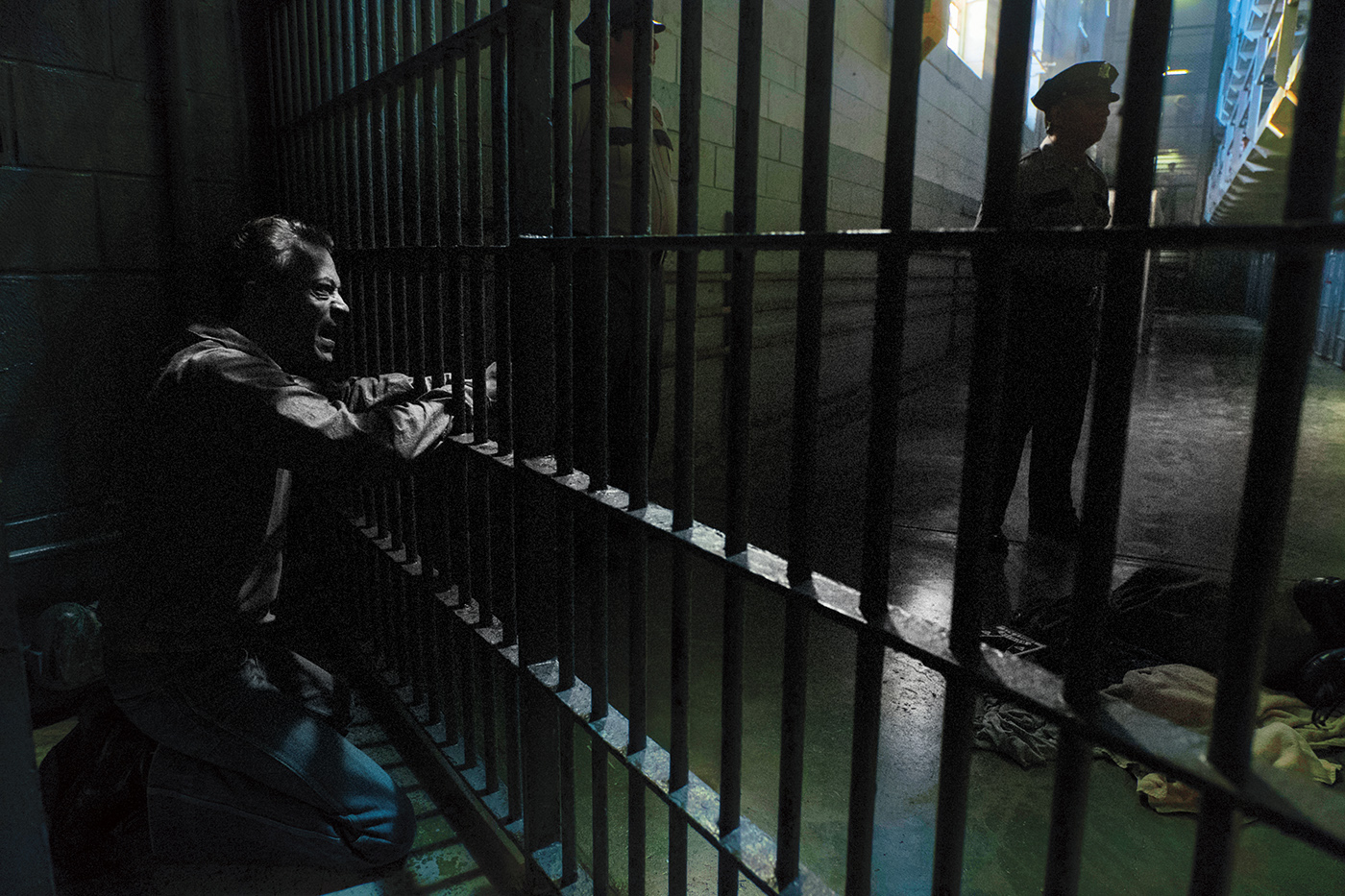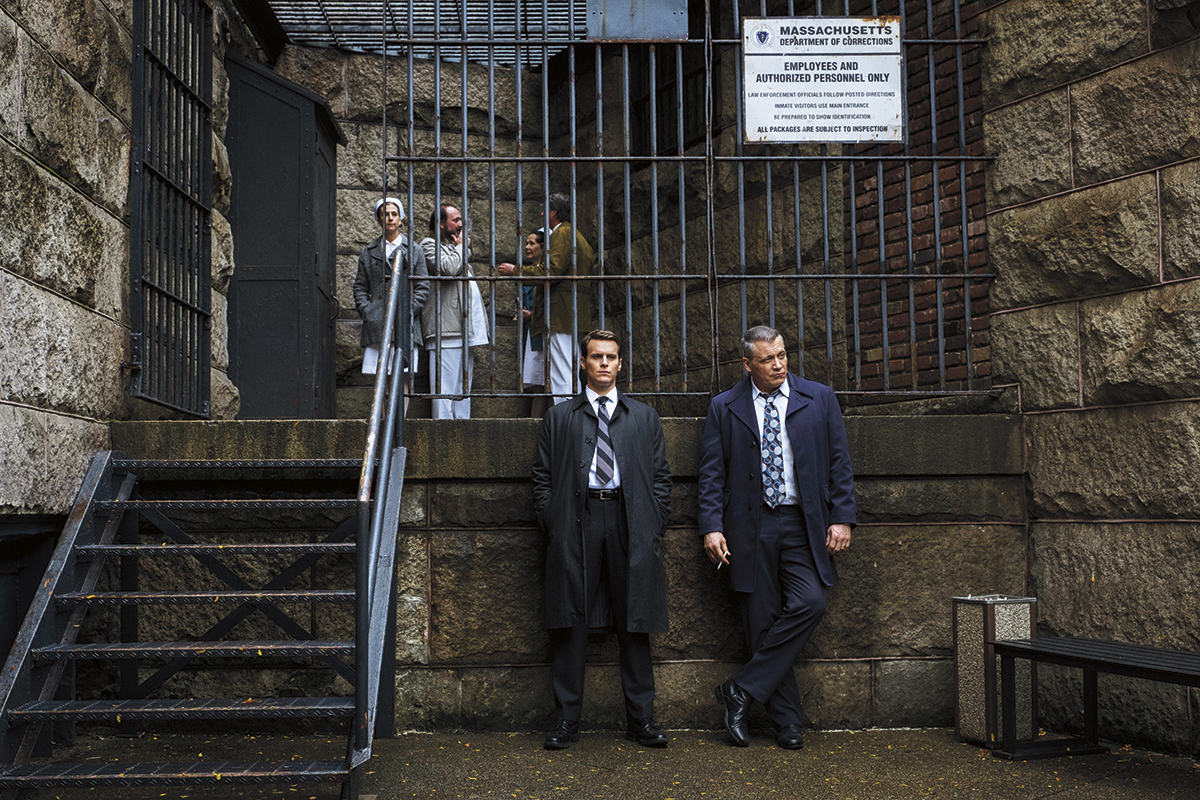
Visualizing the daring and often scary world of David Fincher requires new technologies and processes rarely attempted in series television.
In the Season 1 finale of Netflix’s MINDHUNTER, a disturbed FBI Agent, Holden Ford (Jonathan Groff), bursts wildly from a hospital room, as a handheld camera gives chase. The move begins as shaken as Ford is, but, as it lands with the agent, who collapses in the hallway, it’s as if the camera has floated to a butter-smooth stop inches from the floor, the maneuver executed like it was on a perfectly balanced jib arm, crane, or even Steadicam. But it’s none of those. What can viewers assume from this?
For this series about a pair of agents working in the FBI’s elite Behavioral Sciences Unit in 1979, and attempting to understand the mind of a serial killer, Fincher used a number of leading-edge technologies – interactive LED lighting, custom built high-resolution cameras, and, as in the shot with Agent Ford, image stabilization/smoothing in postproduction – to keep the viewer visually embedded. Fincher’s aim with MINDHUNTER, which has no graphic violence, is for viewers to “access their own attics. There’s far scarier stuff up there than anything we can fabricate,” the filmmaker insists. “I wanted people to register what’s going on in [characters’] eyes and where the gear changes are taking place. At what point do I [as the viewer] feel like, ‘OK, I’ve got an insight,’ and at what point do they feel like: ‘oh, I’m being sold something. It’s all about the nuance in how the balance of power is changing.”
Fincher’s longtime postproduction supervisor, Peter Mavromates, says he creates an “experience of omniscience,” similar to Kubrick’s A Clockwork Orange, “where you’re in a straitjacket with your eyelids pinned open, and David’s forcing you to watch these horrible things.” In fact, the show’s unique visual process began more than a year before production started in Pittsburgh (on area locations and on stages at 31st Street Studios, a former steel mill), with the development of a unique RED camera system.
Christopher Probst, ASC – who shot MINDHUNTER’S pilot and second episode – was asked for his input on a RED prototype system, which had been designed by Jarred Land and RED’s Chief Designer Matt Tremblay according to Fincher’s specific needs. “David wanted to take all of the different exterior add-ons that create a jungle of wires, and put them inside the camera body,” Probst explains.
Fincher puts it even more directly: “It just seems insane that we’ve been bequeathed a [camera] layout [dating back to] D.W. Griffith and Charlie Chaplin that looks like some bizarre Medusa. [The camera] should be something that people want to approach, touch, and pick up.”
In fact, the custom system built for Season 1 [Land created a 2.0 version being used in Season 2] had an RTMotion MK3.1 lens-control system, Paralinx Arrow-X wireless video, and Zaxcom wireless audio (with timecode) integrated into the RED body, with the only visible cable being to control the lens. Slating was all but eliminated, with clip-number metadata being shared wirelessly between the camera and the script supervisor, who used Filemaker software to associate takes and clips. An audio scratch track from the mixer was recorded onto the REDCODE RAW R3D files and received wirelessly.
The base camera was one of RED’s DSMC2 systems, the then-new WEAPON DRAGON, with its 6K sensor. The shell design, accommodating the added gear inside, with its angular shape and heat venting fins on top, had a “Xenomorph” appearance (à la Alien), and was dubbed as such by Land and Fincher. “When the camera arrived in Pittsburgh, they had actually engraved “Xenomorph” on the side,” Probst says.
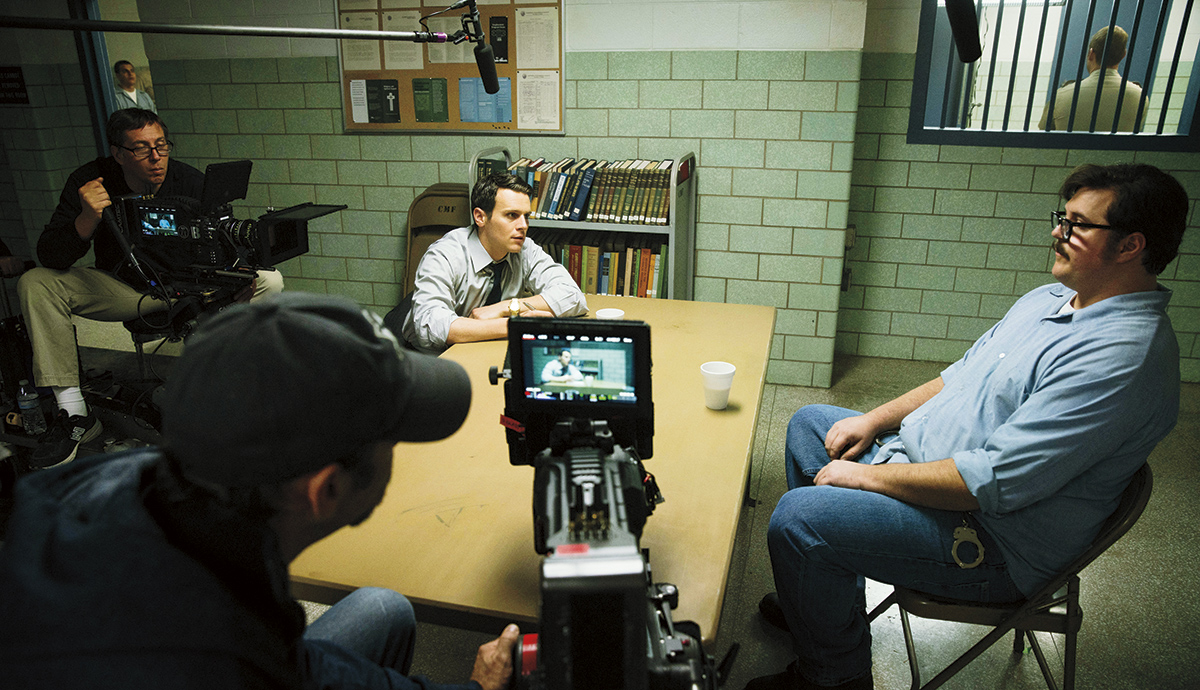
A 7-inch RED monitor was mounted atop the shell for the operator’s use (eyepieces were rarely used, except for occasional bright exteriors). Fincher requested another 7-inch monitor be integrated into the side of the camera for those who might otherwise ask the operator for a quick view.
“David would stand there with me,” describes A-camera Operator Brian Osmond, SOC, “and say, ‘Show me what you got.’ Then he would just look at that side monitor, and I would look at my own. People could walk up to the right side of the camera, take a glance, and say, ‘Okay, I see,’ and walk away. It was a really efficient way to work.”
The design was a favorite with assistants as well. “If you’re in a tight spot, like inside a car, it was nice not having to remove the transmitter or MDR and reconfigure everything,” recalls A-camera 1st AC Alex Scott. “Everything was built in, no cables – just a really clean form factor.”
Since Fincher had used Leica’s Summilux C Series lenses on Gone Girl, Probst tested them on RED’s 8K VistaVision-sized Dragon prototype to determine where each focal length covered the various possible resolutions. Fincher and Probst then decided the lenses would work best on a 6K system, to avoid any portholing effect.
“I love those lenses,” says cinematographer Erik Messerschmidt, a former gaffer and Fincher veteran who replaced Probst on Episode 3 and shot the remainder of the first season. “They’re fast and sharp, and the color is consistent, from lens to lens.”
Messerschmidt says the series was filmed almost entirely on 29- and 40-mm lenses, which, Osmond adds, fit well with the show’s aesthetic.
“We worked close and wide, which is really true to life,” the operator notes. “If you want to see somebody close up, you walk over to them, you don’t change the focal length of your eyes, and those lenses perform well in that way.” The series is also shot in 2.21:1 aspect ratio, which Fincher used on House of Cards. “It’s the equivalent of 70mm 5-perf widescreen spherical.” Fincher notes. “Which is a good aspect ratio for 16:9 displays. To me, 2.40:1 feels chopped in the middle once it gets into a display. It’s a less obtrusive letterbox, and still gives the viewer a widescreen feel.”
As noted, Probst shot the pilot and second episode, and helped develop the look of the series. Messerschmidt served as a consultant during the prep of the show (he was unable to serve as gaffer due to a commitment to Claudio Miranda, ASC, and suggested his former lighting technician, Danny González, be MINDHUNTER’S gaffer). When Messerschmidt took over DP chores, he brought on Focus Puller David Edsall, B-camera operator David Richert, and Key Grip Paul Goodstein. Scott, fellow A-camera assistant Gary Bevans, and Dolly Grip Dwayne Barr were already in place from the pilot and worked the entire season.
“David wanted a low-contrast kind of seventies look,” Messerschmidt recalls. “But he didn’t want to hit the audience over the head with the period; production design and costume design can do most of that work for you.”
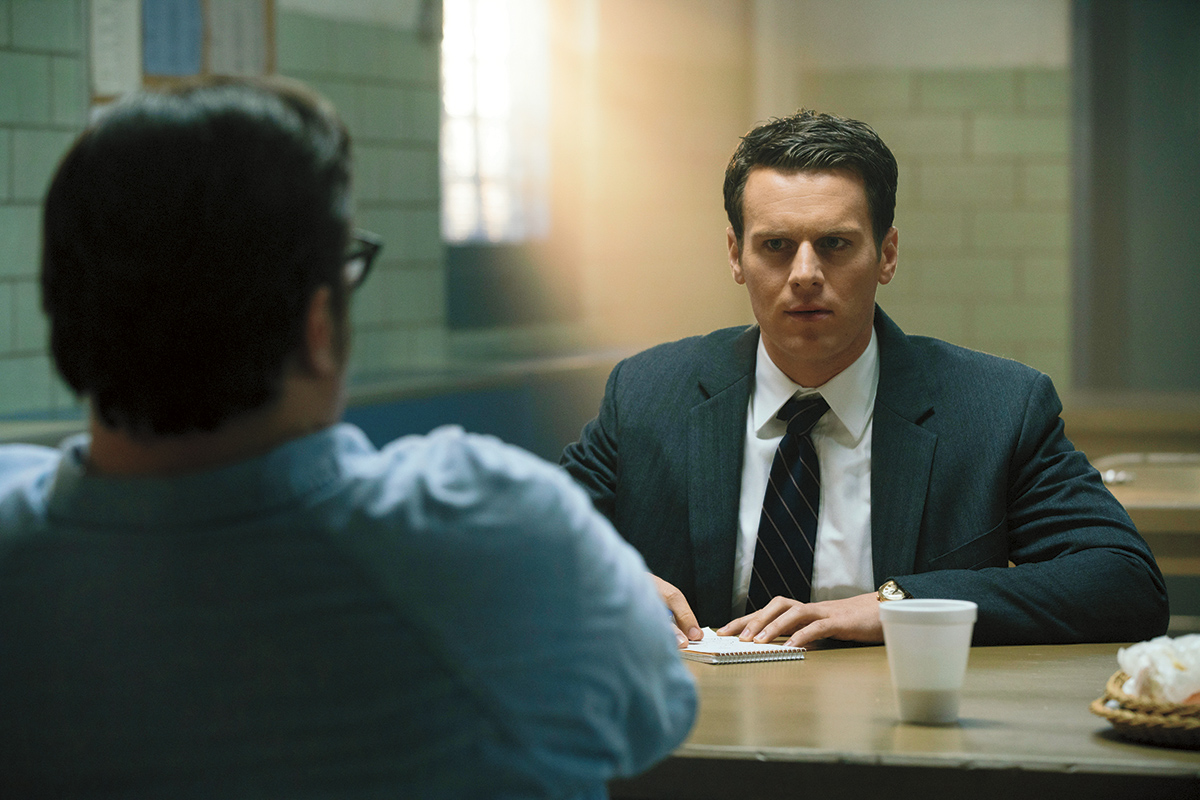
Messerschmidt also brought in a unique visual perspective, having worked as an assistant to renowned still photographer Gregory Crewdson. “[Crewdson’s] work lives right on the edge between reality and surrealism,” he explains. “The audience knows what you’re making is fake – so it’s riding that knife’s edge between telling a real story without letting it be too theatrical.”
González supports that thinking, noting that, “we were constantly adding practicals and lights in the frame, using that to motivate with, and sometimes just using that,” González recounts. “We would always have lights we could put in the frame, and then augment, hiding our sources outside of frame.”
An example would be an expected overhead light purposely left powered off, even though it’s visible in frame, in favor of a lamp. Another would be, in the case of FBI Unit Chief Sheppard (Cotter Smith), lighting mostly from outside the blinds of his large office window. González utilized T8 Technologies’ daylight-balanced Luma Panels (above the window and on the ground), bounced into muslin or gray cloth, to provide a general ambience. Green screen was also used, lit with Cineo HS2 fixtures – panels of uncoated LED emitters, in front of which can be placed panels of phosphors of whatever color is needed. “The HS2s give a rich, saturated green,” González adds. “And if you get a more saturated green, you don’t need as much light, which helps with spill.”
The apartment of Ford’s girlfriend, Debbie, has numerous 1970’s practicals, courtesy of set dresser Tracey Doyle, who Probst notes, “was excited about recreating the environment of her hippie youth.” Instead of hard ceilings overhead, LiteGear LiteMats were placed above stretched muslin for an out-of-frame ambient source to augment the practicals and other custom-made LED sources González would hide. “It gave us a bit of that Conrad Hall ‘room tone’ aesthetic, which worked well for that set,” Messerschmidt adds.
Fans of MINDHUNTER know the agent/serial killer interviews, all done inside the prisons, are at the core of the viewer experience. Scenes with killers Ed Kemper and Jerry Brudos were photographed at Westmoreland County Prison in Greensburg, PA, subbing for California Medical Facility in Vacaville, CA and another in Oregon. Key to the cold and sparse Kemper look were 400 5000K fluorescent bulbs (“super cool whites,” as González calls them), along with pre-rigged lighting that offered three different looks. The closed – and very creepy – West Virginia State Penitentiary in Moundsville, WV sat in for Joliet prison, for visits with murderer Richard Speck [the interview set was built on a stage in Pittsburgh]. “David said: ‘It should look like Dracula’s breakfast nook,’” Messerschmidt laughs.
With so many road-trip conversations between the main characters, Fincher wasn’t about to ruin the experience by using a cheap process methodology. Instead, he used an ingenious combination of realistic, multi-angle plate photography and plate projection on stage as interactive lighting, later comped in post. Far from a “poor man’s process” photography, the high-tech approach produced an uncanny realism.
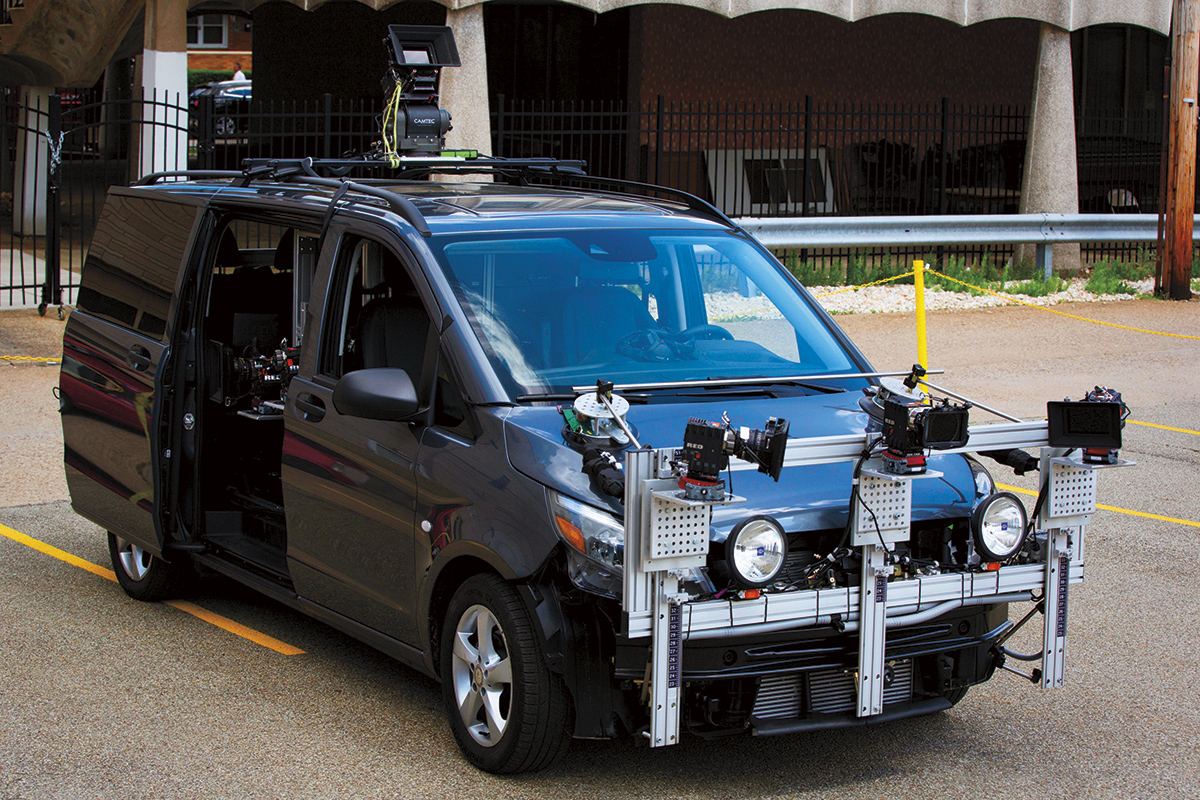
“Riding in a car next to somebody you can see how much the light changes on their face,” Fincher notes about the approach. “We’re so used to seeing these car chases, with 1200-watt Pars blasting into one side of the character’s face, it’s ridiculous.”
Probst set 11 RED EPIC cameras on the plate vehicle (a Mercedes Metris SUV), representing all pre-visualized angles for conversation shots inside a car. He then catalogued the lens height and angles (in loaded vehicles) of the many picture car autos to be used, making a “Denny’s menu” book of information. The cameras were mounted on sliders from Modern Studio Equipment, with vertical scales and rotation angles printed onto “80/20” modular rails, on which the cameras would be raised or lowered to the correct height and angle for the subject car.
After capturing shots of the actors – using the Xenomorphs – arriving or driving through particular locations in their car, another pass was made using the plate vehicle, to easily capture the plate material in the same location, at the same time of day and same lighting that would be used on the process stage.
“You don’t have to reset, circle back for two miles, deal with police escorts and closing streets or ‘Listen, we can only do this two times,’” Osmond notes.
Returning to the process stage, the same vehicle was then placed on jacks (allowing realistic wheel turns) and surrounded by green screen. The editorial department would select footage from the plate shoot, from which Fincher dialed-in his final selects. That was played back on large WinVision Air 9-mm video panels, with shower-curtain-type material placed in front, to diffuse the image. The panels are placed high enough to be out of sight of the camera, but low enough to allow reflection of the blurry, but accurate, content onto window glass, chrome, and the actors’ faces. The result is true interactive lighting: timecode synched, to allow the very same footage to be comped-in behind or ahead of the actors. “If a white truck passes the guys in the plate, there’s a white reflection passing along the chrome of the car,” Messerschmidt describes.
Adds Fincher: “We started using [interactive] LED’s on Zodiac. Now, the LED’s are so efficient and bright, and the color’s so good, they can push completely into the car.”
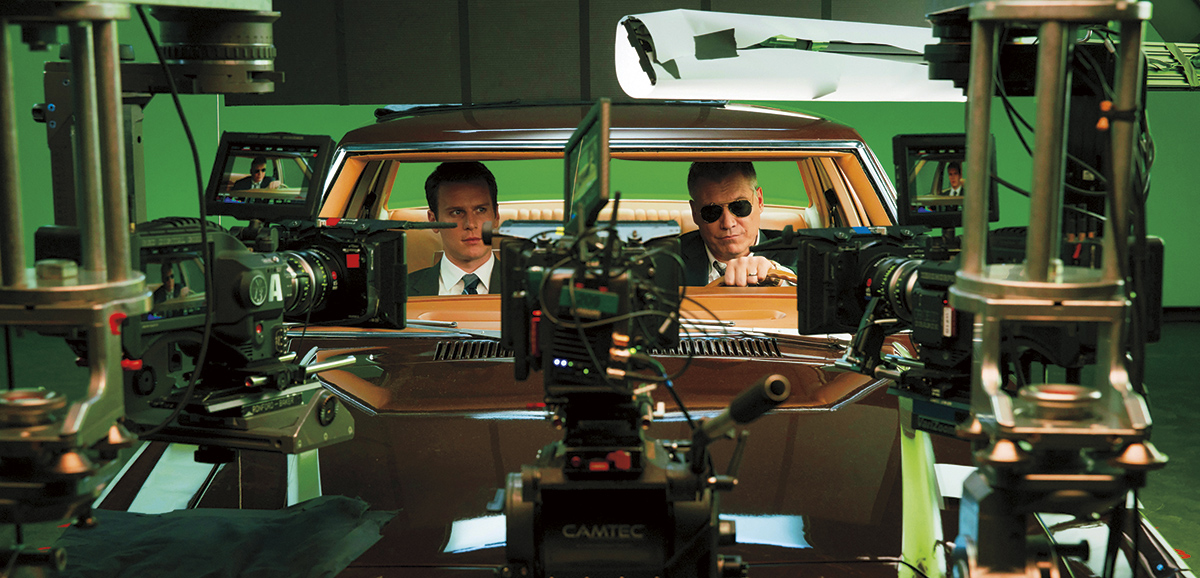
As noted, Fincher’s work often has a unique sense of omniscience. The very precise and deliberate work the Local 600 camera team creates for him on-set is typically augmented or enhanced in postproduction through motion smoothing or stabilization. Fincher first used post-smoothing in 2002’s Panic Room and has refined the process through recent projects like Gone Girl, House of Cards and now MINDHUNTER. By removing even the slightest bump or unwanted motion in a jib arm or dolly move, Mavromates explains, “there’s no reminder a human is involved. You’re floating, almost godlike, because the camera is perfect.”
The process has been perfected in Fincher’s Hollywood offices, which contains a VFX department, editorial, and even color timing on a Baselight by in-house colorist Eric Weidt. Working from Fincher’s notes, compositor Chad Peter uses tracking software (SynthEyes) to export data to Adobe After Effects – used to reanimate the camera operation. “It gives it a stabilized and machine-perfected look,” Mavromates adds.
The same process was also used for reframing.
Probst and Messerschmidt would shoot the show in a 5K-protected frame within the Xenomorph’s 6K frame, leaving 1K worth of border for Mavromates to correct for even the smallest compositional imperfections Fincher or others would identify. But Fincher adds, “reframing is a bad misnomer. To me it’s just combing through [the footage] to remove distracting misses or miscues.”
Although one (or both) processes were used in every shot in which the camera moves, the scene with Agent Holden in the hospital put the methodology to the test. Osmond shot Groff sitting on a butt dolly pulled by Barr in true handheld mode – a rarity for Fincher, who says he only uses handheld “when it’s not in the service of making something cheaper.” As Messerschmidt describes: “David was interested in letting the anxiety of the character take hold – that’s why we ran handheld down the hallway with him. But then, as he completely falls apart, the frame becomes very stable. So it appears to go from handheld to almost Steadicam to motion control.”
“David wanted it physically rough at the start, and then we flew down the hall, and I did my best toward the end of the shot, to hold it as steady as I could, as he hit the ground,” Osmond adds. “I can say I shot handheld for David Fincher – it does happen!”
Messerschmidt puts it best when describing Fincher’s singular approach to moviemaking. “He’s a very purposeful filmmaker. The frame is sacred; what we choose to include is intrinsic to what the audience thinks is important. They are one and the same.”
by Matt Hurwitz
photos by Patrick Harbron & Merrick Morton, SMPSP
LOCAL 600 CREW LIST
Directors of Photography
Christopher Probst, ASC
(Pilot, Episode 2)
Erik Messerschmidt
(Episodes 3-10)
A-Camera Operator
Brian S. Osmond, SOC
A-Camera 1st AC
Alex Scott
B-Camera Operator
David Richert
B-Camera 1st AC
David Edsall
Rick Crumrine
B-Camera 2nd AC
Gary Bevans
Additional AC
Paul Toomey
Loader
Bill Crumrine
Still Photographers
Merrick Morton, SMPSP
Patrick Harbron
